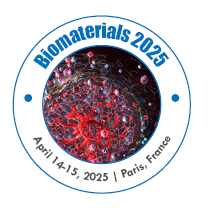About conference
We are extremely pleased and honored to invite attendees from all over the world to our 10th Annual Conference & Expo on Biomaterials which will be held April 14-15, 2025 Paris, France.The program will feature timely keynote addresses, oral presentations, and poster presentations. With interactive panel discussions, keynote lectures, plenary talks, and poster sessions covering topics like polymer biomaterials, dental biomaterials, advanced biomaterials, properties of biomaterials, biomaterials applications, biomaterials companies and market analysis, biomaterials and nanotechnology, tissue engineering and regenerative medicine, biomaterials in delivery systems, biomaterials in biological engineering, biodegradable biomaterials and 3D printing of biomaterials, this scientific event provides the best platform for its audience.
Why to Attend:
Biomaterials 2025 serves as a forum for discussing cutting-edge research techniques in biomaterials research, with the goal of bridging the gap between academia and industry .You will have the finest chance to network with industry leaders, academic presenters, representatives from pharmaceutical companies, decision-makers, and those defining new avenues for the biomaterials industry at our conference. It supports the dynamic value addition of pharmaceutical, biomedical, and R&D enterprises. The development of gene/drug delivery systems, industrializing insights, and gaining knowledge of the newest technology regarding novel biomaterials and bio-nanomaterials are examples of fresh approaches and applications for biomaterials .Novel Approaches for Biomedical Applications are highlighted, along with current appraisals to help you increase your market share. To advance the materials portfolio industrialization paths, learn about the applications of innovative biomaterials and other options for treating serious ailments.
Target Audience:
-
Biomaterials Scientists
-
Biomedical Engineers
-
Material Scientists
-
Tissue Engineers
-
Clinical Researchers
-
Nano materials Experts
-
Orthopedic and Dental Surgeons
-
Drug Delivery Specialists
-
Bio printing Researchers
-
Regulatory Affairs Professionals
-
Biotechnology and Pharmaceutical
-
Medical Device Manufacturers
-
Environmental Scientists
Theme : Biomaterials Beyond Boundaries: Integrating Science, Technology and Healthcare
Sessions and tracks
Track 1: Biocompatibility and Safety of Biomaterials
Biocompatibility is a critical factor in the development and application of biomaterials, ensuring that materials used in medical devices and implants interact harmoniously with biological systems. This involves assessing how materials are accepted by the body without causing adverse reactions such as inflammation, toxicity, or allergic responses. Evaluating biocompatibility involves rigorous testing, including in vitro assays, animal studies, and clinical trials to ensure materials meet safety standards before clinical use. Safety assessments also address the long-term impacts of biomaterials, such as degradation products and their effects on surrounding tissues. Comprehensive safety evaluations help mitigate risks associated with implantation and ensure that biomaterials perform as intended without compromising patient health. Advancements in material science and testing methodologies continue to enhance the understanding of biocompatibility, leading to safer and more effective biomaterials for various medical applications.
Track 2: Smart and Responsive Biomaterials
Smart and responsive biomaterials are designed to react dynamically to environmental changes, such as temperature, pH, or chemical stimuli. These advanced materials offer enhanced functionality by adapting their properties in real-time to meet specific needs in medical applications. For example, temperature-sensitive hydrogels can undergo phase transitions, altering their swelling behavior to release drugs at targeted temperatures. pH responsive polymers can change their structure and release therapeutic agents in response to the acidic environment of a tumor or inflamed tissue. These materials hold significant promise in areas such as controlled drug delivery, tissue engineering, and diagnostic devices. Their ability to respond to biological signals enables more precise and effective treatments, reducing side effects and improving patient outcomes. As research progresses, the integration of smart and responsive biomaterials into clinical practice is expected to revolutionize personalized medicine and enhance therapeutic strategies.
Track 3: Biomaterials in Wound Healing and Tissue Repair
Biomaterials play a crucial role in advancing wound healing and tissue repair by providing structural support and promoting tissue regeneration. These materials, including hydrogels, collagen matrices, and bioactive dressings, create an optimal environment for wound healing. They offer benefits such as enhanced moisture retention, controlled drug release, and infection prevention. Advanced biomaterials can also facilitate the regeneration of complex tissues by mimicking the natural extracellular matrix, thereby supporting cell adhesion and proliferation. Recent innovations include materials with embedded growth factors or antimicrobial agents to accelerate healing and reduce complications. Additionally, biodegradable biomaterials ensure gradual integration with the tissue while minimizing the need for removal. By addressing various aspects of wound management and tissue repair, biomaterials are improving outcomes in both acute and chronic wounds, and paving the way for more effective and personalized therapeutic approaches in regenerative medicine.
Track 4: Bioinformatics and Computational Modeling in Biomaterials
Bioinformatics and computational modeling are pivotal in advancing the field of biomaterials by providing tools for designing, analyzing, and optimizing materials at a molecular level. Through bioinformatics, researchers can analyze large datasets to identify biomolecular interactions and predict how materials will behave in biological environments. Computational modeling complements this by simulating material performance, including mechanical properties, degradation rates, and biological responses. These techniques enable the rapid screening of potential biomaterials and the fine-tuning of their properties before experimental trials, significantly reducing development time and costs. For instance, molecular dynamics simulations can predict how biomaterials interact with cells, while finite element analysis can assess the material's mechanical stability. Integrating bioinformatics and computational modeling accelerates the discovery of novel materials and enhances the customization of biomaterials for specific medical applications, driving innovation and improving outcomes in regenerative medicine and tissue engineering.
Track 5: Biomaterials in Orthopedics and Bone Regeneration
Biomaterials are pivotal in orthopedics and bone regeneration, offering innovative solutions for repairing and replacing damaged bone tissues. Key applications include implants, scaffolds, and grafts designed to support bone healing and growth. Materials such as bioactive ceramics, synthetic polymers, and composites are engineered to mimic the natural bone matrix, providing structural support and promoting cellular activity Bioactive materials like hydroxyapatite and tricalcium phosphate integrate with bone and stimulate natural bone formation. Scaffolds made from biodegradable polymers support the growth of new bone by providing a temporary structure that gradually dissolves as new tissue forms. Additionally, advanced materials with drug delivery capabilities can release growth factors or antibiotics to enhance healing and prevent infections .These innovations are transforming orthopedic treatments, offering more effective solutions for fractures, joint replacements, and bone defects, and significantly improving patient outcomes and recovery times.
Track 6: Biomaterials for Cardiovascular Applications
Biomaterials play a crucial role in advancing cardiovascular medicine by providing innovative solutions for treating heart and blood vessel conditions. Key applications include stents, heart valves, and vascular grafts, designed to restore and maintain cardiovascular function. Materials such as stainless steel, nitinol, and polymer composites are used in stent design to ensure flexibility, durability, and biocompatibility while minimizing the risk of thrombosis and restenosis.Bioengineered heart valves made from synthetic and biological materials mimic the function of natural valves, enhancing patient outcomes in valve replacement surgeries. Additionally, vascular grafts crafted from biocompatible polymers or collagen provide effective alternatives for bypass surgeries and vessel repair.Recent advancements include the development of smart materials that respond to environmental stimuli and the incorporation of regenerative techniques to repair damaged tissues. These innovations are improving the performance, safety, and longevity of cardiovascular implants, ultimately leading to better patient care and recovery.
Track 7: Surgical Applications of Biomaterials
Biomaterials are increasingly integral to modern surgical procedures, enhancing outcomes through their diverse applications. They are used in a range of surgical interventions, including implants, prosthetics, and tissue repair. Materials such as titanium alloys, biodegradable polymers, and hydrogels are chosen for their strength, flexibility, and biocompatibility, tailored to meet specific surgical needs. Implants like orthopedic plates, screws, and dental implants are crafted from biomaterials that integrate seamlessly with bone and other tissues. Prosthetics, including artificial limbs and joint replacements, rely on advanced materials to mimic natural function and improve patient mobility. Biomaterials also play a key role in wound healing, with specialized dressings and scaffolds that promote tissue regeneration and reduce infection risks.Innovations in biomaterials are driving the development of minimally invasive surgical techniques and personalized implants, ultimately improving patient safety, recovery times, and overall surgical efficacy.
Track 8: Emerging Trends in Biodegradable Biomaterials
Emerging trends in biodegradable biomaterials are reshaping the landscape of medical and environmental applications. These materials, designed to degrade naturally within the body or the environment, offer significant advantages in reducing long-term complications and waste. Recent advancements focus on enhancing the performance and versatility of biodegradable materials through innovative chemistry and material science.Key trends include the development of advanced polymers and composites that degrade at controlled rates, allowing for precise timing in medical applications such as drug delivery systems and tissue scaffolds. Researchers are exploring bioresorbable metals and ceramics for temporary implants, which dissolve after fulfilling their function, minimizing the need for surgical removal.Another trend is the integration of smart technologies into biodegradable materials, enabling them to respond to biological stimuli and release therapeutic agents in a controlled manner. These innovations promise to improve patient outcomes, reduce environmental impact, and advance sustainable practices in biomaterials development.
Track 9: Biomaterials for Diagnostic and Imaging Technologies
Biomaterials are revolutionizing diagnostic and imaging technologies by enhancing the precision, sensitivity, and functionality of these tools. Advanced biomaterials are used to develop contrast agents, biosensors, and imaging probes that improve the accuracy of medical imaging and diagnostic procedures. For instance, nanoparticles and quantum dots are employed as contrast agents in magnetic resonance imaging (MRI) and fluorescence imaging, providing clearer and more detailed images of biological tissues.Biomaterials also play a crucial role in the development of biosensors that can detect specific biomarkers for early disease diagnosis. These sensors, often incorporating functionalized polymers or nanomaterials, offer rapid, sensitive, and accurate detection of various conditions, from infections to cancer.Moreover, innovations in biomaterials enable the creation of multifunctional imaging probes that combine diagnostic and therapeutic capabilities, paving the way for personalized medicine and targeted treatments. These advancements are significantly improving diagnostic accuracy and patient care. Biomaterials are pivotal in advancing diagnostic and imaging technologies, offering enhanced capabilities for detecting and monitoring diseases. Innovations in this field involve developing advanced contrast agents, imaging probes, and biosensors. For example, nanoparticles and functionalized polymers are used as contrast agents in magnetic resonance imaging (MRI) and computed tomography (CT) scans, providing high-resolution and targeted imaging of tissues and organs.
Track 10: Biomaterials in Cancer Treatment and Oncology
Biomaterials are transforming cancer treatment and oncology by enhancing therapeutic strategies and improving patient outcomes. Key applications include the development of targeted drug delivery systems, tissue engineering solutions, and innovative implants. Biomaterials such as nanoparticles and micelles are engineered to deliver chemotherapeutic agents directly to tumor cells, minimizing systemic side effects and improving treatment efficacy.Additionally, biomaterials are used in the creation of smart delivery systems that release drugs in response to specific stimuli, such as the acidic environment of a tumor. Tissue engineering techniques also leverage biomaterials to create scaffolds that support the growth of artificial tissues or organs, aiding in cancer research and regenerative medicine. Furthermore, biomaterials are employed in diagnostic imaging and monitoring, enhancing the precision of cancer detection and treatment response evaluation. These advancements are driving more personalized and effective approaches to cancer therapy, with the potential for significant improvements in patient care.
Track 11: The Role of Biomaterials in Infection Control
Biomaterials play a critical role in infection control across various medical applications by incorporating antimicrobial properties and promoting safe healing environments. Antimicrobial coatings on medical devices, such as catheters and implants, prevent microbial colonization and reduce the risk of infections. Drug-eluting materials, which release antibiotics or antimicrobial agents over time, offer sustained protection against bacterial infections. Biodegradable biomaterials can also be engineered to degrade in a controlled manner, reducing the risk of chronic infection associated with long-term implants. Additionally, bioactive materials that support the immune response or enhance tissue regeneration contribute to a more robust defense against infections. Innovative materials like silver nanoparticles and graphene-based composites are being explored for their potent antimicrobial effects. These advancements in biomaterials not only improve patient outcomes by minimizing infection risks but also contribute to the overall safety and efficacy of medical interventions.
Track 12: Biomaterials for Aesthetic and Reconstructive Surgery
Biomaterials play a crucial role in aesthetic and reconstructive surgery, offering solutions for enhancing both function and appearance. In aesthetic surgery, biomaterials such as collagen-based gels and hyaluronic acid fillers are used to improve skin texture, volume, and contour, providing non-surgical options for facial rejuvenation. Silicone implants and polyurethane foam are commonly used in breast augmentation and reconstruction, offering durable and biocompatible options. For reconstructive procedures, bioengineered scaffolds and 3D-printed implants support the repair and replacement of damaged tissues and organs, ensuring better integration and functionality. Additionally, tissue-engineered grafts derived from biomaterials can help in reconstructing complex anatomical structures, facilitating recovery and restoring form and function. Advances in biomaterials are continually improving surgical outcomes, reducing recovery times, and enhancing the overall aesthetic results in both elective and reconstructive surgeries.
Track 13: Biomaterials for Neurological Applications
Biomaterials for neurological applications are revolutionizing treatments for brain and spinal cord injuries, neurodegenerative diseases, and neurological disorders. These specialized materials are designed to interface with neural tissues, support regeneration, and enhance functional recovery. Key innovations include neural implants, such as deep brain stimulators and brain–machine interfaces, which use biocompatible materials to stimulate neural activity and restore lost functions. Advanced biomaterials, including hydrogels and scaffolds, provide structural support for nerve regeneration and repair. These materials can be engineered to release growth factors or drugs to promote neuronal survival and regeneration. For spinal cord injuries, bioengineered conduits and scaffolds help bridge gaps and guide axon growth. Emerging technologies in nanomedicine also offer targeted delivery of therapeutics to the brain, minimizing side effects and improving treatment efficacy. These advancements are crucial for developing novel therapies, enhancing patient outcomes, and addressing complex neurological challenges.
Track 14: Sustainability in Biomaterials Development
Sustainability in biomaterials development focuses on creating materials that are both environmentally friendly and economically viable. This approach prioritizes the use of renewable resources, minimizing waste, and reducing the environmental impact of biomaterial production and disposal. Key strategies include developing biodegradable polymers and composites that break down safely after use, reducing reliance on non-renewable resources and minimizing landfill contributions. Innovations in sustainable biomaterials also involve recycling and repurposing materials, such as using waste products from other industries as raw materials. Life cycle assessments help evaluate the environmental impact of biomaterials from production to disposal, guiding the design of more sustainable options.The integration of green chemistry principles, energy-efficient manufacturing processes, and eco-friendly packaging further supports sustainability. By focusing on these practices, the biomaterials industry can contribute to a more sustainable future while advancing medical and technological application
Track 15: Bioactive Materials and Surface Modification
Bioactive materials and surface modification are critical for enhancing the interaction between biomaterials and biological tissues. Bioactive materials are designed to actively engage with biological systems, promoting specific cellular responses and improving integration with surrounding tissues. These materials, such as bioactive glasses and ceramics, can stimulate cell growth, tissue regeneration, and bone formation through their chemical and physical properties. Surface modification techniques further refine these interactions by altering the surface characteristics of biomaterials to enhance their performance. Methods such as coating with bioactive molecules, nanoparticle incorporation, and plasma treatment can improve cell adhesion, reduce inflammation, and increase resistance to bacterial colonization.
Track 16: Biomaterials for Gene and Cell Therapy
Biomaterials play a pivotal role in advancing gene and cell therapy by providing essential support for the delivery, protection, and function of therapeutic genes and cells. In gene therapy, biomaterials such as nanoparticles, liposomes, and hydrogels are engineered to encapsulate and deliver genetic material (e.g., plasmids or RNA) to target cells efficiently. These materials ensure controlled release and protect the therapeutic genes from degradation, enhancing the efficacy of gene delivery. For cell therapy, biomaterials offer a supportive scaffold for cell growth and differentiation. Scaffolds made from natural or synthetic polymers create an environment that mimics the extracellular matrix, promoting cell attachment and tissue formation. Additionally, biomaterials can be functionalized with bioactive molecules to guide cell behavior and integration. Overall, the integration of biomaterials into gene and cell therapies enhances precision, improves therapeutic outcomes, and advances the development of personalized treatments for a variety of diseases.
Track 17: Advanced Coatings and Surface Treatments for Biomaterials
Advanced coatings and surface treatments are crucial for optimizing the performance and biocompatibility of biomaterials used in medical applications. These techniques enhance the interaction between biomaterials and biological systems, improving their functionality and longevity. Coatings such as antimicrobial layers, hydrophilic or hydrophobic surfaces, and bioactive films can modify the material's surface properties to prevent infection, reduce friction, or promote cell adhesion. For instance, antimicrobial coatings help minimize the risk of infections associated with implants and devices. Hydrophilic coatings can enhance wettability and reduce friction, making them ideal for applications like catheter coatings. Surface treatments, including plasma treatment, chemical vapor deposition, and electrospinning, enable precise control over surface characteristics. These methods can introduce functional groups, adjust surface roughness, or create nanoscale textures to optimize material-tissue interactions. Overall, advanced coatings and surface treatments are key to improving the performance, safety, and effectiveness of biomaterials in various medical applications
Track 18: Challenges in Translational Biomaterials Research
Translational biomaterials research faces several challenges as it seeks to move discoveries from the lab to clinical practice. One major hurdle is bridging the gap between laboratory findings and real-world applications, which often requires overcoming differences in scale, complexity, and biological variability. Translating promising research into safe and effective clinical solutions involves rigorous testing and validation, which can be time-consuming and costly. Another challenge is addressing regulatory requirements and ensuring compliance with standards for safety and efficacy. Navigating the regulatory landscape can be complex, particularly for novel materials and technologies. Additionally, there may be difficulties in scaling up production processes and ensuring consistent quality and performance across different manufacturing batches. Collaboration between researchers, clinicians, and industry partners is essential to address these challenges effectively. By fostering interdisciplinary partnerships and focusing on practical, patient-centered outcomes, the field can advance more efficiently and translate innovations into meaningful clinical benefits.
Track 19: Biomaterials for Antibacterial and Antiviral Applications
Biomaterials for antibacterial and antiviral applications are designed to prevent and control infections, a critical concern in medical settings. These materials incorporate active agents or surface modifications that inhibit the growth of bacteria and viruses. Innovations in this field include the development of antimicrobial coatings and impregnated materials used in medical devices such as catheters, implants, and wound dressings. Antibacterial biomaterials often feature coatings with silver nanoparticles, copper ions, or natural compounds like chitosan that exhibit broad-spectrum antimicrobial activity. Antiviral materials may include coatings or particles that disrupt viral replication or bind to viral particles, preventing their attachment to host cells. Recent advancements also explore the integration of responsive elements that release antimicrobial agents in response to environmental triggers, such as infection or inflammation. These smart materials enhance infection control, reduce the need for systemic antibiotics, and contribute to better patient outcomes in clinical settings.
Track 20: Biomaterials for Gastrointestinal Applications
Biomaterials for gastrointestinal (GI) applications are advancing the treatment and management of digestive system disorders. These materials are used in devices and implants designed to interact with the GI tract, such as stents, drug delivery systems, and surgical meshes. Key developments include biocompatible polymers and hydrogels that conform to the unique environment of the GI tract, ensuring safe and effective use. Materials like biodegradable polymers are employed in the development of controlled-release drug delivery systems that target specific areas within the digestive system, improving therapeutic efficacy and reducing systemic side effects. Additionally, advanced coatings and surface treatments enhance the functionality of GI implants by providing protection against erosion and minimizing biofilm formation. Innovations also include bioengineered scaffolds and tissue-engineered constructs for repairing or replacing damaged GI tissues. These advancements are pivotal in improving patient outcomes, reducing complications, and offering new solutions for chronic gastrointestinal conditions.
Market Analysis
The biomaterials market has emerged as one of the most dynamic and rapidly evolving sectors within the broader field of biotechnology and medical devices. Biomaterials are materials engineered to interact with biological systems for therapeutic or diagnostic purposes. These materials can be derived from natural sources, such as collagen and chitosan, or synthesized from metals, polymers, ceramics, and composites. The application of biomaterials spans a wide range of medical fields, including orthopedics, cardiology, dentistry, wound care, and tissue engineering. The market's growth is fueled by several factors, including an aging population, technological advancements, increasing prevalence of chronic diseases, and growing demand for minimally invasive surgical procedures. One of the primary drivers of the biomaterials market is the global aging population. As the population ages, the incidence of chronic conditions such as osteoarthritis, cardiovascular diseases, and dental problems increases. These conditions often require medical interventions that involve the use of biomaterials, such as joint replacements, cardiovascular stents, and dental implants. According to the World Health Organization, the global population aged 60 years and above is expected to reach 2.1 billion by 2050, up from 1 billion in 2020. This demographic shift is anticipated to drive the demand for biomaterials, particularly in developed regions like North America and Europe, where the elderly population is growing rapidly.
Technological advancements in biomaterials have also played a crucial role in the market's expansion. Innovations in material science, nanotechnology, and biotechnology have led to the development of next-generation biomaterials with enhanced properties, such as improved biocompatibility, biodegradability, and mechanical strength. For instance, the advent of bioresorbable polymers has revolutionized the field of cardiovascular stents, providing a temporary scaffold that gradually dissolves after fulfilling its function, thereby reducing long-term complications associated with permanent implants. Similarly, advances in 3D printing technology have enabled the fabrication of complex, patient-specific implants and tissue scaffolds, opening new possibilities in personalized medicine and regenerative therapies. The increasing prevalence of chronic diseases is another significant factor driving the biomaterials market. Conditions such as diabetes, cardiovascular diseases, and cancer are on the rise globally, leading to a growing need for medical devices and implants that incorporate biomaterials. For example, the use of biomaterials in drug delivery systems allows for targeted and controlled release of therapeutics, improving treatment efficacy and reducing side effects. In oncology, biomaterial-based implants are being developed to deliver chemotherapy directly to tumor sites, minimizing systemic exposure and enhancing patient outcomes. Additionally, the rising incidence of orthopedic conditions, such as osteoporosis and rheumatoid arthritis, has spurred the demand for bone grafts, joint replacements, and spinal implants, further boosting the biomaterials market. Government support and funding for research and development (R&D) activities in biomaterials have also contributed to the market's growth. Many governments and regulatory bodies have recognized the potential of biomaterials to address unmet medical needs and improve patient care. As a result, they have increased funding for biomaterials research, streamlined approval processes for innovative products, and established favorable reimbursement policies. In the United States, for example, the National Institutes of Health (NIH) and the Department of Defense (DoD) have provided substantial grants for biomaterials research, particularly in the areas of regenerative medicine and wound care. Similarly, the European Union's Horizon 2020 program has allocated significant resources to advance biomaterials research and innovation. The biomaterials market can be segmented based on material type, application, and geography. By material type, the market includes metallic, polymeric, ceramic, and natural biomaterials. Metallic biomaterials, such as titanium and stainless steel, are widely used in orthopedic and dental implants due to their excellent mechanical properties and biocompatibility. Polymeric biomaterials, including polyethylene and polylactic acid, are used in a variety of applications, from cardiovascular stents to drug delivery systems, owing to their versatility and tunable properties. Ceramic biomaterials, such as hydroxyapatite and zirconia, are favored for their high wear resistance and compatibility with bone tissue, making them ideal for orthopedic and dental applications. Natural biomaterials, including collagen, gelatin, and hyaluronic acid, are increasingly being used in tissue engineering and wound healing due to their biodegradability and ability to mimic the extracellular matrix. By application, the biomaterials market is divided into orthopedics, cardiology, dentistry, wound care, plastic surgery, ophthalmology, and tissue engineering, among others. Orthopedics is one of the largest segments, driven by the high demand for joint replacements, bone grafts, and spinal implants. The cardiology segment is also significant, with biomaterials being used in the fabrication of stents, heart valves, and pacemakers. The dental segment is growing rapidly, fueled by the increasing adoption of dental implants and bone grafts. In wound care, biomaterials are used to develop advanced dressings, tissue adhesives, and scaffolds for tissue regeneration. The tissue engineering segment is emerging as a key growth area, with ongoing research focused on developing biomaterial-based scaffolds for organ regeneration and repair. Geographically, the biomaterials market is segmented into North America, Europe, Asia-Pacific, Latin America, and the Middle East & Africa. North America dominates the market, owing to its well-established healthcare infrastructure, high healthcare expenditure, and strong presence of key market players. The United States is the largest market within this region, driven by a high prevalence of chronic diseases, a large elderly population, and extensive R&D activities. Europe is the second-largest market, with countries like Germany, France, and the United Kingdom leading in biomaterials adoption and innovation. The Asia-Pacific region is expected to witness the highest growth rate during the forecast period, driven by increasing healthcare spending, rising awareness about advanced medical treatments, and the growing prevalence of chronic diseases. China, India, and Japan are key markets within this region, with significant potential for market expansion. Latin America and the Middle East & Africa are emerging markets, with growth driven by improving healthcare infrastructure and increasing access to advanced medical technologies. The competitive landscape of the biomaterials market is characterized by the presence of several global and regional players, including Johnson & Johnson, Medtronic, Zimmer Biomet, Stryker Corporation, BASF, and DSM Biomedical, among others. These companies are focusing on strategic initiatives such as mergers and acquisitions, partnerships, and product launches to strengthen their market position and expand their product portfolios. For instance, in recent years, several leading companies have acquired smaller firms specializing in innovative biomaterials technologies to enhance their capabilities and gain a competitive edge. Additionally, collaborations between biomaterials companies and research institutions are becoming increasingly common, aimed at accelerating the development and commercialization of novel biomaterials.
Accreditation
All major Conference Series Conferences are accredited with Continuing Education (CE), Continuing Professional Development (CPD) and Continuing Medical Education (CME) credits respectively.
CME Credits:
Continuing Medical Education (CME) refers to a specific form of continuing education that helps medical professionals to maintain competence and learn about new and developing areas of their field. Conference Series Conferences are recognised and accredited with CME credits to enhance the professional abilities and skills of participants. CME credits are important to physicians because they require a specified number of credits annually to maintain medical licenses. CME credits are authorized by the Accreditation Council for Continuing Medical Education. Attending CME accredited conference is beneficial and valuable to physicians and other medical professional as it is a source of constant improvement that ultimately improves their medical practice, and keeps them up-to-date on the latest technologies, advancements, treatments, etc. Speaking at CME activities can also be a great stage for clinical medical professionals to share their expertise and increase their distinction in their specialty.
CE Credits:
Continuing Education (CE) credit is a measure used in continuing education programs to assist the professional to maintain his or her license in their profession. Conference Series Conferences provides ample opportunities to acquire CE credits. CE can open up previously closed doors and lead to better job opportunities. CE usually refers to college courses or other vocational training obtained by older adults or working professionals. CE credits work as carrier promoter and hold great value in medical, clinical and other areas of research even after completion of degrees in concerned field of research. It is pivotal in today’s world to get updated information on your field of research and profession. Attending Continuing Education Conferences can help expand your network and make connections that could translate into profitable relationships or job opportunities down the line. It also plays a vital role in recruiting new team members for an employer with open positions. CE helps licensing organizations and professional membership groups. Continuing Education promotes high quality performance, keep professionals up to date with the latest advances, and provide excellent networking opportunities.
CPD Credits:
Continuing Professional Development (CPD) is the holistic commitment of professionals towards the enhancement of personal skills and proficiency throughout their careers. It enables learning to become conscious and proactive, rather than passive and reactive. CPD accreditation is important because it ensures that courses provided adhere to the highest educational standards and international benchmarks of quality and learning. CPD enriches your knowledge, keeps you currently competent and is the key to career progression and professional growth. There are many advantages to carrying out CPD that includes filling gaps in your knowledge and skills to become more productive and efficient, building confidence and credibility to stand out from the crowd, achieving your career goals and demonstrating professional status. CPD hours can be earned through continuing education, leadership activities, instructional activities, completion of significant work projects, research and publications. Conference Series Conferences have been accredited with CPD credits to expedite the progress of research and industry professionals.
Past Conference Report
Biomaterials 2024
We take immense pleasure and feel honoured in welcoming the participants over the Globe to attend our 9th Annual Conference & Expo on Biomaterials (Biomaterials 2024) during May 30-31, 2024 in Vienna, Austria which includes prompt keynote presentations, Oral talks, Poster Presentations. This scientific event offers the best platform with its well organized scientific program to the audience, which comprises of interactive panel discussions, keynote lectures, plenary talks and poster sessions on the subjects like Polymer Biomaterials, Dental Biomaterials, Advanced Biomaterials, Properties of Biomaterials, Biomaterials Applications, Biomaterials Companies and Market Analysis, Biomaterials and Nanotechnology, Tissue Engineering and Regenerative Medicine, Biomaterials in Delivery Systems, Biomaterials in Biological Engineering, Biodegradable Biomaterials and 3D Printing of Biomaterials.
Conference Series LLC Ltd organizes a Conference Series of 3000+ Global Events with over 600+ Conferences, 1200+ Symposiums and 1200+ Workshops in the USA, Europe & Asia with support from 1000+ Scientific Societies and publishes 700+ Open access journals which contain over 30,000 eminent personalities, reputed Scientists as editorial board members.
Why Should I Attend?
Biomaterials 2024 acts as a podium for bridging the gap between Academia and Industry through discussion on Innovative research methods in Biomaterials Science. Our Conference gives you the best opportunity to meet the Industrial experts, Academic speakers, Pharmaceutical Companies, Decision-Makers, Interacting and Defining novel prospects in Biomaterials business. It helps in dynamically adding value to biomedical, Pharmaceutical and R&D businesses. Novel Approaches and Applications about Biomaterials like the gene/Drug Delivery Systems Development and Industrializing insights & gain Knowledge of latest technologies about novel Biomaterials and Bio-Nanomaterials. It emphasizes on Novel Approaches for Biomedical Applications and up to date appraises to drive your market share accordingly. Learn on the Applications of Innovative Biomaterials and other alternatives for treating major diseases to progress the materials portfolio Industrialization pathways. Biomaterials as a field have seen rapid growth over its approximately half-century of existence and use ideas from Medicine, Biology, Chemistry, Materials-Science and Engineering. There is also a powerful human side to Biomaterials that considers Ethics, Law and the Healthcare delivery system. The Biomaterials market has been expected to reach 149.17$ Billion by 2021 from an assessed 70.90$ Billion in 2016, at a CAGR of 16.0%. The Growth of Biomaterials market (Metallic, Ceramic, Polymers, and Natural) can be attributed by increased funds & grants by government-bodies Worldwide.
Past Reports Gallery


























